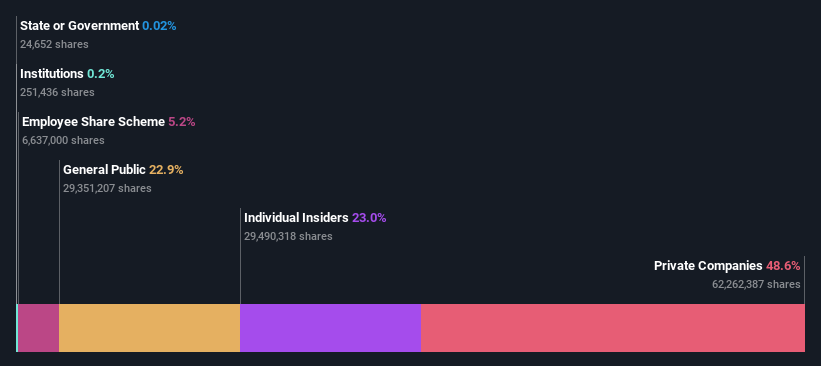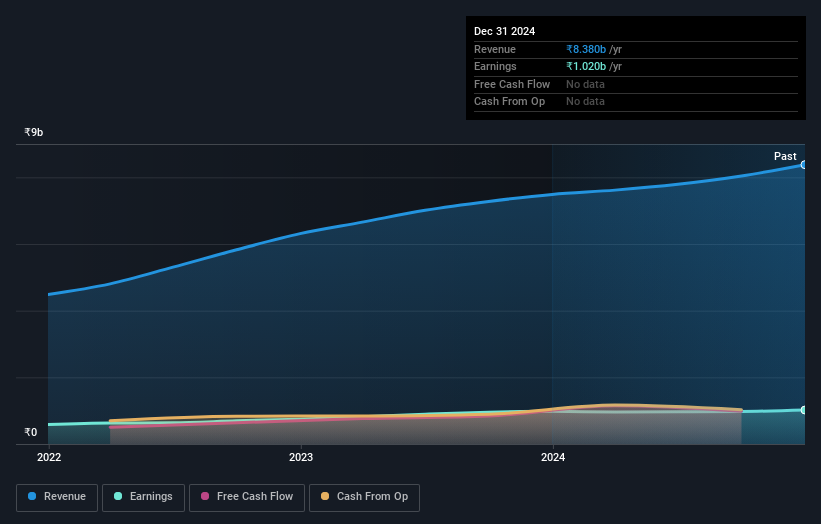Private companies invested in Saksoft Limited (NSE:SAKSOFT) up 12% last week, insiders too were rewarded
Key Insights
- The considerable ownership by private companies in Saksoft indicates that they collectively have a greater say in management and business strategy
- The top 2 shareholders own 70% of the company
- 23% of Saksoft is held by insiders
Every investor in Saksoft Limited (NSE:SAKSOFT) should be aware of the most powerful shareholder groups. And the group that holds the biggest piece of the pie are private companies with 49% ownership. Put another way, the group faces the maximum upside potential (or downside risk).
While private companies were the group that benefitted the most from last week’s ₹2.2b market cap gain, insiders too had a 23% share in those profits.
Let's take a closer look to see what the different types of shareholders can tell us about Saksoft.
View our latest analysis for Saksoft

What Does The Lack Of Institutional Ownership Tell Us About Saksoft?
Institutional investors often avoid companies that are too small, too illiquid or too risky for their tastes. But it's unusual to see larger companies without any institutional investors.
There are many reasons why a company might not have any institutions on the share registry. It may be hard for institutions to buy large amounts of shares, if liquidity (the amount of shares traded each day) is low. If the company has not needed to raise capital, institutions might lack the opportunity to build a position. Alternatively, there might be something about the company that has kept institutional investors away. Saksoft might not have the sort of past performance institutions are looking for, or perhaps they simply have not studied the business closely.

Saksoft is not owned by hedge funds. SAK Industries Ltd. is currently the largest shareholder, with 49% of shares outstanding. Meanwhile, the second and third largest shareholders, hold 22% and 5.2%, of the shares outstanding, respectively. Aditya Krishna, who is the second-largest shareholder, also happens to hold the title of Chief Executive Officer.
A more detailed study of the shareholder registry showed us that 2 of the top shareholders have a considerable amount of ownership in the company, via their 70% stake.
While it makes sense to study institutional ownership data for a company, it also makes sense to study analyst sentiments to know which way the wind is blowing. As far as we can tell there isn't analyst coverage of the company, so it is probably flying under the radar.
Insider Ownership Of Saksoft
While the precise definition of an insider can be subjective, almost everyone considers board members to be insiders. Management ultimately answers to the board. However, it is not uncommon for managers to be executive board members, especially if they are a founder or the CEO.
Most consider insider ownership a positive because it can indicate the board is well aligned with other shareholders. However, on some occasions too much power is concentrated within this group.
Our most recent data indicates that insiders own a reasonable proportion of Saksoft Limited. It has a market capitalization of just ₹21b, and insiders have ₹4.8b worth of shares in their own names. This may suggest that the founders still own a lot of shares. You can click here to see if they have been buying or selling.
General Public Ownership
The general public-- including retail investors -- own 23% stake in the company, and hence can't easily be ignored. This size of ownership, while considerable, may not be enough to change company policy if the decision is not in sync with other large shareholders.
Private Company Ownership
Our data indicates that Private Companies hold 49%, of the company's shares. It might be worth looking deeper into this. If related parties, such as insiders, have an interest in one of these private companies, that should be disclosed in the annual report. Private companies may also have a strategic interest in the company.
Next Steps:
While it is well worth considering the different groups that own a company, there are other factors that are even more important.
Many find it useful to take an in depth look at how a company has performed in the past. You can access this detailed graph of past earnings, revenue and cash flow.
Of course this may not be the best stock to buy. So take a peek at this free free list of interesting companies.
NB: Figures in this article are calculated using data from the last twelve months, which refer to the 12-month period ending on the last date of the month the financial statement is dated. This may not be consistent with full year annual report figures.
New: Manage All Your Stock Portfolios in One Place
We've created the ultimate portfolio companion for stock investors, and it's free.
• Connect an unlimited number of Portfolios and see your total in one currency
• Be alerted to new Warning Signs or Risks via email or mobile
• Track the Fair Value of your stocks
Have feedback on this article? Concerned about the content? Get in touch with us directly. Alternatively, email editorial-team (at) simplywallst.com.
This article by Simply Wall St is general in nature. We provide commentary based on historical data and analyst forecasts only using an unbiased methodology and our articles are not intended to be financial advice. It does not constitute a recommendation to buy or sell any stock, and does not take account of your objectives, or your financial situation. We aim to bring you long-term focused analysis driven by fundamental data. Note that our analysis may not factor in the latest price-sensitive company announcements or qualitative material. Simply Wall St has no position in any stocks mentioned.
About NSEI:SAKSOFT
Saksoft
An information technology company, provides digital transformation solutions in Europe, the United States, the Asia Pacific, and internationally.
Flawless balance sheet established dividend payer.
Market Insights
Community Narratives




